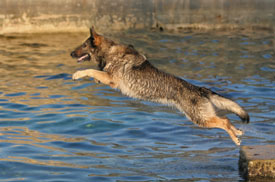A chilly start
On New Year’s Day my otherwise wonderfully sane son-in-law took his family to the beach and went for a swim. Big deal, right? But this is Boston. The temperature was 11 degrees at my house that morning. We had just had a big snowstorm and were expecting another. Even the ocean was practically frozen.

Karl and a friend have been celebrating New Year’s Day with a Polar Bear swim for some years now. They like to do it. It’s my idea of extreme punishment, but their idea of fun.
Would non-human animals ever do something like that? KPA graduate and Certified Training Partner Dan De La Rosa asked me, “Can a punisher also be a reinforcer?”
Dan says that Shutzhund working dogs take stick hits from the target person they are attacking, and come back fighting for more. It seems that they do not see the stick hits as punishment. Some world-class trainers describe these dogs as adrenalin addicts.
Choose your words carefully
The short answer to Dan's question: don’t equate an aversive stimulus with a punishment. A punishment, technically, is anything that shortens or stops a behavior. If someone hit you or me with a stick, we might do less of whatever we did that triggered an adversary to strike at us; however, a fighter might do more. I shrink at the very thought of swimming in freezing water; Karl jumps in, once a year.
An aversive stimulus is not necessarily punishing, it depends on circumstances and on the recipient. Rain is punishing to cats, who might respond by going inside, reinforcing to ducks, who might respond by going outside, and a matter of indifference to cows, who stay where they are. And circumstances can change one’s view of what’s punishing. We primates generally seek shelter in a downpour, but Gene Kelly, having just fallen in love, famously sang and danced in the rain.
We need to separate the “thing”—the cookie or the stick or the click or the cold water or whatever—from its outcome. What defines its function is not what it looks like to common sense, but how it changes the behavior. If that stick doesn't slow the dog down, then no matter how scary it looks to us, it's not functioning as a punisher.
It’s the same with reinforcers. If the dog won't take the treat, no matter how delicious it looks to us, then in that situation the treat is not a reinforcer. I see people petting dogs effusively, under the assumption that they are giving the dog pleasure. If you look at the dog, though, it’s showing an eye white or ducking away from the pat or shaking off the unwanted contact. At that moment, with that dog, your effusiveness is definitely not a positive experience.
Technically, a reward or a punisher has no specific definition; it’s just anything we’ve chosen that we think our learner might like or might avoid. Only the individual doing the behavior can truly tell what sort of “postcedent” or subsequent event any particular item might be.
The behaviors of seeking apparent aversives or avoiding apparent rewards illustrate the often-misunderstood subtleties of B.F. Skinner’s thinking. His vocabulary deals with processes and outcomes, not with specific items or events.
Find out more
Want to delve deeper? I recommend a new textbook, Behavior Analysis for Effective Teaching, by Julie Skinner Vargas. It’s the best explication I’ve ever read of operant conditioning. It goes back to Skinner’s first discoveries. It goes forward to modern training by integrating throughout the text the uses and functions of secondary reinforcers as used in clicker training and TAGteaching (technologies that previous behavior analysis textbooks either get wrong or ignore). The book is aimed at grade school teachers, but it serves any of us who teach anyone or anything. It is a college textbook—long, complex, expensive—but worth having on your shelf and dipping into often. There’s enlightenment on every page.
Happy New Year,
Karen Pryor



Expensive doesn't mean unavailable
Thank you for such clear examples and another resource.
Folks, don't let the cost of a book, video, or cd stop you from obtaining the knowledge.
I've learned to use my local library and 'Inter Library Loan' to gain access to books like this.
If your local library doesn't have a copy, they can almost certainly get you a copy (with a little patience) from another library.
For $3 my library will borrow books on my behalf from 3,000 and 4,000 miles away.
It allows me to focus my spending dollars on the materials that really are indispensable.
-J, Anchorage AK
Great clarification!
Karen, Thank you so much for addressing this! Getting us all to use the same terms in the proper way helps so much.
Post new comment